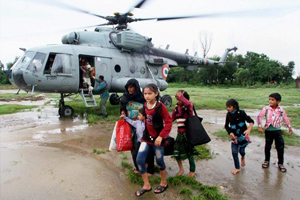Srinagar, Sep 14: Mobile services were partially restored Saturday in flood-hit Jammu and Kashmir as rescue and relief efforts continued on a war footing. The receding floodwaters revealed the death of 43 people, including 14 children in an inundated government hospital here.
Over 1,42,000 people have been rescued so far from various parts of the state by the armed forces and the National Disaster Response Force (NDRF), an official statement said Saturday.
Union Telecom Minister Ravi Shankar Prasad said in New Delhi that mobile services have been "somewhat" restored in the state, barring Poonch.
He said the state-run Bharat Sanchar Nigam Limited (BSNL) was allowing free calls for one week and private telecom players were allowing 60 minutes free talk time every day.
Fourteen children died in the government-run G.B. Pant Hospital here. The hospital and other major hospitals in the city, including the Shri Maharaja Hari Singh (SMHS) and the Government Medical College (GMC), were inundated in the floods.
The 14 children were among the 43 people found dead in the Kashmir Valley as flood waters began receding in the state.
State government officials confirmed to IANS that 29 bodies were found in the Kashmir Valley alone after the flood waters receded.
Officials said there was four to 10 feet of flood waters in the residential areas of Shivpura, Rajbagh, Jawahar Nagar, Wazirbagh, Gogjibagh, Karan Nagar, Shetrashahi, Bemina, Qamarwari and some other areas in Srinagar.
The main business hubs of the city - Lal Chowk, Residency Road, Maisuma, Hari Singh High Street and Karan Nagar - are still submerged. The financial loss to businesses in these markets is estimated to be in several crores.
The markets in the old city areas of Srinagar have been closed for the last six days because of shortage of goods, although these areas have not been affected by floods directly.
The Srinagar-Jammu national highway through which all supplies are routed to the land-locked valley remained closed for the sixth day Saturday. Efforts were on to restore this lifeline to Kashmir.
Chief Minister Omar Abdullah has confirmed that all records of the state's premier financial institution - The Jammu and Kashmir Bank Ltd. - were safe and people need not worry about their deposits.
People were seen lining up in unending queues at petrol pumps in north Kashmir's Ganderbal district.
Authorities have started bringing in petroleum products into the valley through the Manali-Leh-Srinagar highway that is open for traffic.
More than 15,000 people from different parts of the country are waiting at the Srinagar airport to be flown out of the flood-ravaged valley, officials said.
Although the local radio station and Doordarshan are still unable to resume services, an alternative arrangement was started Friday by airing flood-related messages through the Prasar Bharati-controlled FM station here.





Comments
Add new comment